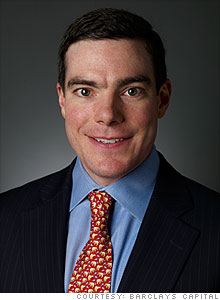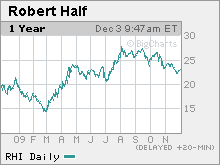Long-term prospects for a temp staffer
Two analysts face off on what the future holds for Robert Half International.
 |
| The Bear: Gary Bisbee, Barclays Capital |

 |
| The Bull: Tim McHugh, William Blair |
| MMA | 0.69% |
| $10K MMA | 0.42% |
| 6 month CD | 0.94% |
| 1 yr CD | 1.49% |
| 5 yr CD | 1.93% |
NEW YORK (Fortune) -- With unemployment around 10%, temporary help is one of the few areas of the economy that's adding jobs: After cutting payrolls to the bone, businesses are realizing they still need to get the work done.
Temporary help services added 34,000 jobs in October, according to the Bureau of Labor Statistics, but put that up against an average of 44,000 monthly jobs lost from January 2008 through July 2009.
White-collar temp staffer Robert Half International (RHI) is still smarting from the downturn: Third-quarter profit fell 86% from a year ago. Can the company join a rebound, or is there more trouble on the horizon? We talked to two analysts and got their takes.
"I remain negative on the near-term prospects for RHI. We expect an anemic employment recovery, which will lead to a slow profit recovery at the business. I don't expect the company to regain peak earnings from this past up-cycle until at best 2012 and more likely 2013. Based on that expectation, we think the stock is expensive where it's trading right now.
"We expect a weak employment recovery partly because historically small businesses have driven the initial stages of return to employment growth. If you look at the last recession, small businesses began hiring eight quarters before large businesses. Small businesses today are having difficulty getting financing from banks due to the lingering impact of the credit crunch. This has also hurt access to other small business financing options, including home equity and credit cards.
"Also for small businesses the looming healthcare reform could be a big negative that keeps them from hiring. The recently passed House health reform bill included a fine equal to 8% of payroll for businesses not offering employer-sponsored health insurance, which would increase the cost of employing people significantly for small businesses.
"The business is 70% in the U.S., which continues to face employment declines and rising unemployment. Over the last two recessions we've had a jobless recovery occur, in which the economy returns to solid GDP growth for at least a year before material employment growth emerges.
"If you look at the mix of staffing, Robert Half is the dominant company in professional staffing, which tends to hold up longer before falling off, but also rebounds later than less skilled labor.
"In terms of valuation, the stock is trading at 50 plus times 2010 earnings and more than 22 and half times our estimate of $1.03 for 2011. We think it's unlikely that the company achieves its prior peak earnings until 2013.
"So while we believe that RHI remains a well-run company that will eventually achieve new peak earnings, we expect a weak employment recovery through much of 2010. This may disappoint investors who expect a more rapid earnings rebound for the business, and we believe will lead the stock to underperform the market over the next six months."
"We think Robert Half is a high-quality business with good long-term growth prospects, a proven management team, and the highest returns on capital in the industry.
"The stock is trading at a valuation that is close to the levels it has historically troughed at during a recession. Right now it trades at 12 times its prior peak earnings per share. If you went back to the trough of the last cycle, the lowest price it reached was 13 times the prior peak EPS during that cycle. This gives us some comfort that we are trading near the company's cyclical lows.
"We think Robert Half will continue to generate strong growth during the next economic cycle. We believe the secular shift toward professional-level temporary staffing will remain strong during the next few years because companies continue to seek more flexibility in their labor force, and this remains a relatively less mature part of the temporary staffing industry.
"There also are some industry-specific drivers for the accounting and finance temporary staffing industry, such as an increase in government regulations and the shift to international accounting standards. Given these trends, we think it is reasonable to project EPS of $2.50 to $3.00 or perhaps better at the peak of the next cycle. Applying a 20 P/E to that earnings potential implies a $50 to $60 stock is possible over the next four to five years.
"We recognize the current demand trends are relatively weak, although the upturn in temporary staffing employment during the last few months is modestly encouraging. We also recognize that demand for blue-collar employment tends to rally sooner than at the professional level, and the company does generate a portion of its revenue from permanent placement services, which tend to be later cycle in nature. The market tends to anticipate that.
"If you look back at the last cycle, the company outperformed the S&P 500 by about 41 percentage points during the first 18 months of the stock market recovery and by 68 percentage points during the first three years of recovery. We would not wait to see revenues start to surge or recover quickly before we started to build a position in a high quality name such as this one." ![]()
-
 The retail giant tops the Fortune 500 for the second year in a row. Who else made the list? More
The retail giant tops the Fortune 500 for the second year in a row. Who else made the list? More -
 This group of companies is all about social networking to connect with their customers. More
This group of companies is all about social networking to connect with their customers. More -
 The fight over the cholesterol medication is keeping a generic version from hitting the market. More
The fight over the cholesterol medication is keeping a generic version from hitting the market. More -
 Bin Laden may be dead, but the terrorist group he led doesn't need his money. More
Bin Laden may be dead, but the terrorist group he led doesn't need his money. More -
 U.S. real estate might be a mess, but in other parts of the world, home prices are jumping. More
U.S. real estate might be a mess, but in other parts of the world, home prices are jumping. More -
 Libya's output is a fraction of global production, but it's crucial to the nation's economy. More
Libya's output is a fraction of global production, but it's crucial to the nation's economy. More -
 Once rates start to rise, things could get ugly fast for our neighbors to the north. More
Once rates start to rise, things could get ugly fast for our neighbors to the north. More







